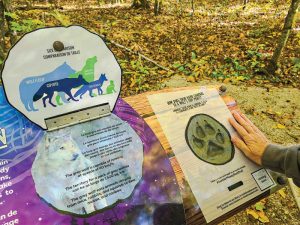
Each wheelchair-accessible, interactive interpretive sign includes 3D and/or movable elements for users to engage with, along with Anishinaabemowin, English, and French text to enhance the learning experience.
The signs were mounted on 152.4- x 152.4-mm (6- x 6-in.) pressure-treated wood posts. The holes were also dug using a two-man post auger, and the posts were buried in the ground. The steel brackets and aluminum support frames were fabricated in-house, and the signs were affixed using stainless steel hardware. The team also secured some of the elements with very high bond (VHB) double-sided tape
Selfie sign
The selfie station provides an opportunity for users to commemorate their visit to the trail. The 1524- x 1473.2-mm (60- x 58-in) printed ACM frame is supported with in-house welded steel brackets and mounted on 152.4- x 152.4-mm pressure-treated wood posts.
Similar to the trail markers and interpretive signs, a two-man post auger was used to dig the holes, and the posts were buried in the ground. The frame was attached with stainless steel hardware.
All signage components are protected with overlaminate.
Weathering the storm
As with many sign projects during this time, the team’s first challenge throughout the process was the pandemic. It affected how everyone communicated with each other, but it also made them more forgiving when it came to timelines. Overall, Bittner’s team and the Laird Signs crew stayed positive when dealing with any provincial guideline changes and kept timelines loose and realistic.
The changing seasons and weather were also a factor, due to the outdoor location of the project. As winter frost presented less than desirable conditions for sign installation, the team did their best to plan ahead. They marked locations, dug holes for posts and foundations, and installed the posts before the ground began to freeze.
Whenever possible, the team navigated through the winter weather, using a snowmobile and a sleigh to transport materials and equipment to their locations along the trail. They used their time indoors to build the brackets and frames, print the vinyl, finish the interactive components, and put the signs together.
Once they were assembled, and the weather permitted, the signs were transported to their respective locations and mounted to the posts.
This particular project taught the team at Laird Signs a variety of new techniques, including how to make signs wheelchair accessible and how to create interactive elements suitable for both kids and adults. They also learned how to use a 3D printer and include those elements in a sign application.
For their efforts in designing and creating the Mossy Rock Trail, the town of Blind River and the Mississauga First Nation won a 2021 Destination Northern Ontario Tourism Industry Leader Award.
The project wrapped up in spring 2022, ready for people of all ages, backgrounds, and abilities to enjoy.






